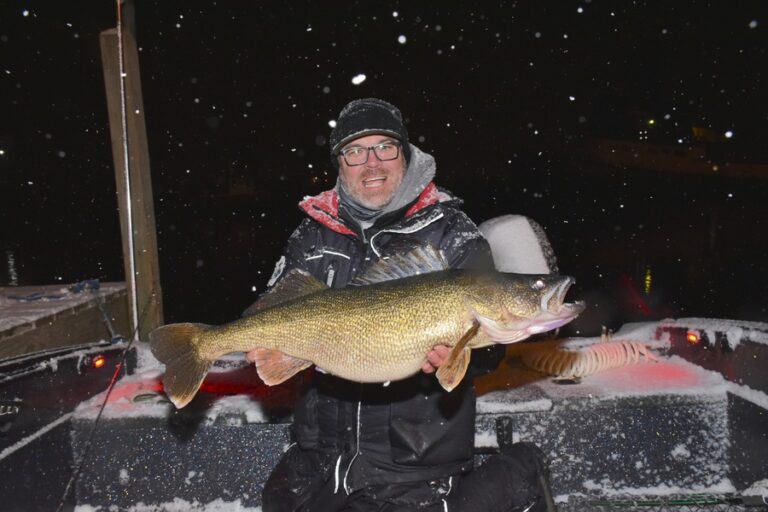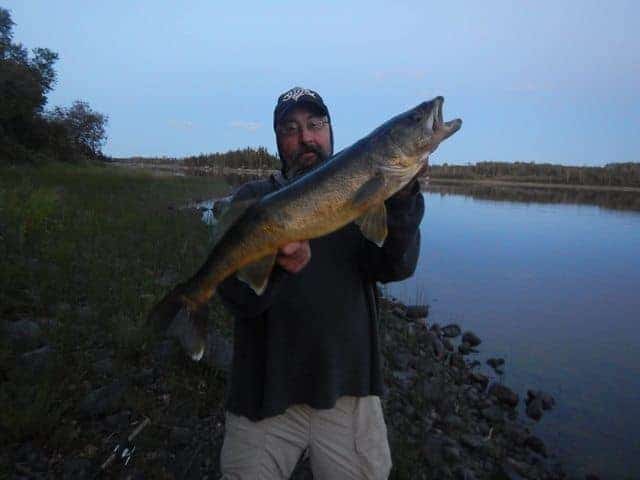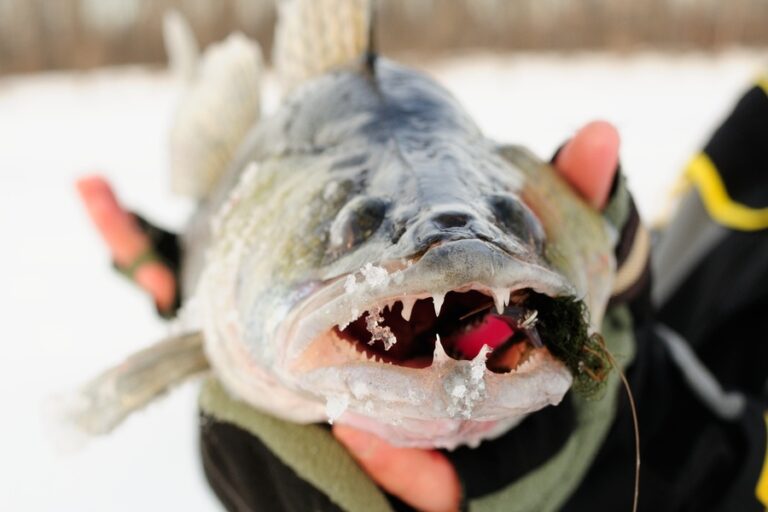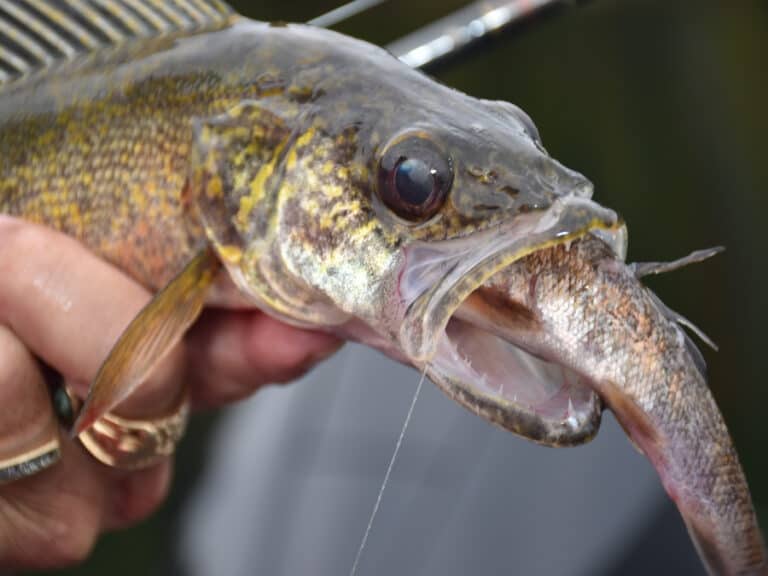Daytime Water Clarity for Walleye Fishing: Complete Guide
Water clarity impacts walleye fishing in numerous ways.
Water clarity directly influences walleye location: they dive deeper in clear waters for protection and rise shallower in murkier conditions. Use natural, subtle lures in clear conditions and opt for vibrant, noisy lures in murky waters to attract walleye.
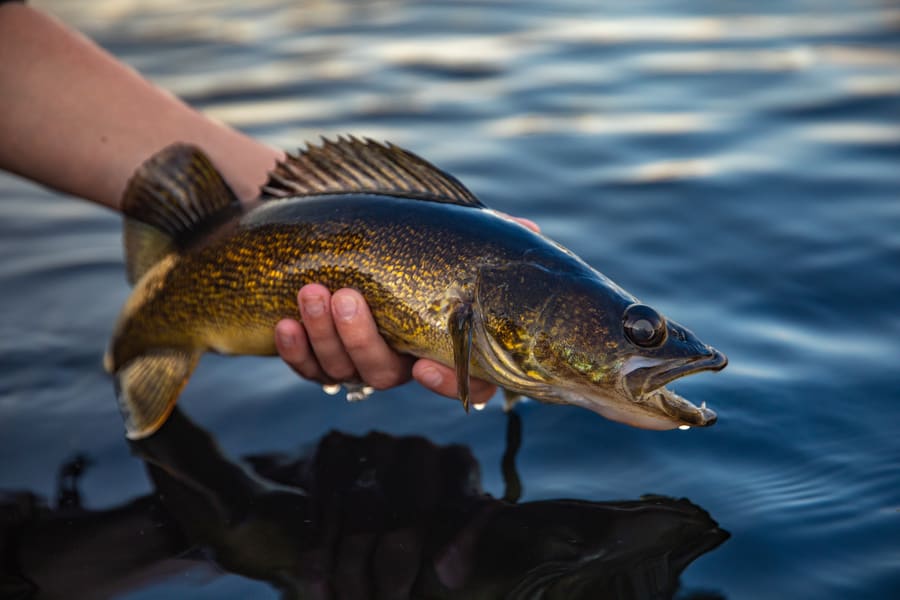
Table of Contents
Best Daytime Water Clarity for Walleye Fishing
For walleye fishing during the day, the best water clarity is where it’s a bit cloudy but not too murky. Walleye see well in dim light, so they prefer water where they can see without being easily spotted. Too clear water makes them uneasy, while very murky water can make it hard to find food.
Why Water Clarity Matters
Walleyes see better in murky waters than most other fish. When the water is too clear during the day, walleye feel exposed but have much clearer visibility of baitfish. On the flip side, if the water is too cloudy, it can even be hard for walleye to find their food.
Factors That Influence Water Clarity
Several things can change how clear the water is:
- Rain: Heavy rain can stir up mud and dirt from the bottom of the lake or river, making the water murkier.
- Algae: High algae numbers can make the water look green and less clear.
- Water Current: Fast-moving water can stir things up and cloud the water. On the other hand, calm water lets dirt settle, making it clearer.
- Human Activity: Things like boating & swimming can stir up the water, while some industry runoff may also impact clarity.
Fishing Approaches That Work
The Transition Zones
- Insight: Walleyes often patrol transitional zones where two different types of underwater terrains meet (e.g., sand to rock or gravel to mud).
- Tactic: These transition zones can be deeper than expected in clear waters. Look for subtle underwater changes and cast your line across these borders.
UV Lures
- Insight: Some lures are designed to reflect ultraviolet (UV) light, penetrating deeper into water than visible light.
- Tactic: In waters of moderate clarity, where neither clear nor murky strategies work best, UV lures can stand out and attract walleye from greater distances.
The Thermocline Tie-In
- Insight: In clearer lakes, during summer, a thermocline (a layer of water where temperature changes rapidly) develops. Walleyes often suspend near this layer as it’s rich in oxygen and baitfish.
- Tactic: Use a depth finder to locate the thermocline and adjust your fishing depth accordingly.
Sound Tactics
- Insight: In murkier waters, walleyes rely more on their lateral line to detect vibrations.
- Tactic: Use lures that emit vibrations. Blade baits or those with built-in rattles can be especially effective in such conditions.
Weather-Water Clarity Connection
- Insight: Post-frontal conditions can make clear waters even clearer and cause walleyes to become lethargic.
- Tactic: Slow down your retrieval speed and opt for live bait. Walleyes might be less willing to chase, but a slow-moving, easy meal can be tempting.
Night Tactics for Clear Water
- Insight: In ultra-clear waters, walleyes might become more nocturnal, feeding heavily after sundown.
- Tactic: Consider night fishing using luminous or glow-in-the-dark lures. The soft illumination can be irresistible to walleyes.
Observational Feeding Patterns
- Insight: Walleyes in clearer waters might feed on different prey species than those in murky waters.
- Tactic: Take note of local forage. For instance, if you see walleyes feeding on smelt in clear waters, adjust your lure choice to mimic that prey.
Suspended Strategies
- Insight: Especially in clearer water bodies, walleyes might not always be at the bottom. They can be suspended mid-water, following schools of baitfish.
- Tactic: Don’t just fish the bottom. Use techniques like trolling with planer boards to target mid-depth roaming walleyes.
Moonlit Murkiness
- Insight: Moon phases can influence walleye behavior, especially in clear waters.
- Tactic: With increased nighttime visibility in clear lakes during the full moon, consider using more subtle lures to mimic the natural forage closely.
Click here to learn how weather impacts walleye fishing.
Daytime Water Clarity for Walleye Fishing
Different clarity levels affect walleye behavior, where they go, and how you should fish for them.
Clear Water
In clear water, walleye become more cautious but will readily feed.
- Feeding Behavior: Walleye typically feeds during dawn or dusk, relying on lower light conditions.
- Location & Depth: They often retreat to deeper waters or stick close to structures like underwater logs, rocks, or weed beds for cover during the day.
- Fishing Approach: A slower, stealthy approach works best. Use natural-looking lures that closely resemble their prey.
- Lure Type/Color: Natural colors like brown, green, or silver are most effective.
- Challenges: With their heightened caution, they might be harder to lure in.
- Advantages: Clear water allows for easier spotting and casting accuracy.
Murky or Stained Water
Murky water is slightly cloudy with some color.
- Feeding Behavior: Walleye feel safer and may feed throughout the day but still with some caution.
- Location & Depth: They might be found at mid-depths, often near transition areas where muddy water meets clearer water.
- Fishing Approach: A moderate retrieval speed and a bit more noise, like rattling lures, can be effective.
- Lure Type/Color: Bright colors or metallic finishes can be helpful to catch their attention.
- Challenges: Determining their exact location can be trickier.
- Advantages: Their increased activity levels can lead to more opportunities.
Turbid or Muddy Water
In highly turbid waters, visibility is pretty lousy.
- Feeding Behavior: Walleye rely heavily on their sense of smell and vibrations to locate food.
- Location & Depth: They’ll often move shallower, close to the shoreline or areas with reduced current, to avoid debris.
- Fishing Approach: Using lures that make vibrations or noise, like spinnerbaits or rattling crankbaits, is beneficial.
- Lure Type/Color: Bright, contrasting colors or even glow-in-the-dark lures can be effective.
- Challenges: The limited visibility means they’re less likely to pursue lures for long distances.
- Advantages: Walleye are less cautious and can strike aggressively when they detect food.
Water Clarity for Walleye Fishing: Seasonal & Daily Variations
Spring
- Walleye Movement: They gravitate towards inflowing streams or river mouths, seeking cleaner waters from melting ice or spring rains. They also stay closer to the bottom where silt doesn’t reach as much.
- Tactics: Target areas near inflows. Use brighter lures or those that vibrate to stand out in murkier conditions. Also, consider fishing at dawn or dusk when walleyes come shallower to feed.
Summer
As the days heat up, water clarity can become a mixed bag.
- Algae Blooms: This can decrease visibility in the upper layers.
- Walleye Movement: They often migrate to deeper, cooler waters during the day, where clarity is better but light is dim. They also frequent the thermocline, a layer where temperatures change, often holding a lot of baitfish.
- Tactics: Use deep-diving crankbaits or weighted jigs to reach them. Natural and metallic colors can mimic baitfish in these zones. Fish closer to the surface during early morning or late evening when they come up to feed.
Fall
The transition of fall can bring a variety of water conditions.
- Walleye Movement: As temperatures cool, walleyes roam more freely, often venturing into mid-depths. They follow baitfish schools, also transitioning between deep and shallow areas.
- Tactics: Use medium-diving lures, and watch for bird activity on the surface (a hint that baitfish are near). Vary your retrieval speeds to mimic erratic baitfish movements.
Winter
- Walleye Movement: With reduced light, they often stay in mid-depths, close to food sources. They’re also found near the bottom, where smaller fish seek refuge.
- Tactics: Ice fishing with jigs tipped with live minnows can be very effective. Due to the dim light, glow-in-the-dark lures or those with some sparkle can attract more attention.
Times of the Day
- Dawn: Walleyes move to shallower waters, using the low light to ambush prey.
- Midday: They retreat to deeper, clearer zones to avoid the bright sunlight and heat.
- Dusk: Again, they become active in the shallows, using the dimming light to their advantage.
- Tactics: Adjust your depth based on the time of day. Early and late, fish shallow with lighter lures. Midday, go deeper with natural or shiny lures.
Water Clarity: Times of the Day
Dawn: As the sun rises, walleye might move to shallower waters, where it’s a bit murky, to hunt for breakfast.
Midday: When the sun’s high, they might go deeper where it’s clearer and cooler. It’s a good time to fish in deeper zones.
Dusk: As the sun sets, they feed to the murkier shallows to eat.
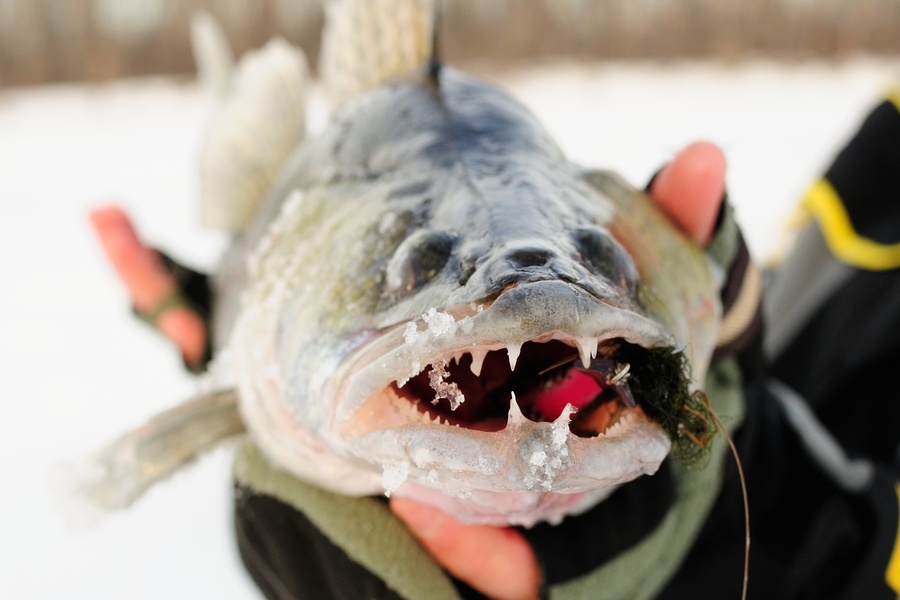
Walleye Tactics Based on Water Clarity
Tactics
- Clear Water:
- Depth is Key: In clear conditions, walleyes swim deeper to avoid the bright sunlight. Find them near underwater structures or deeper parts of the lake during midday.
- Stealth Approach: Use a quiet approach with your boat and cast longer distances to ensure you don’t scare them away.
- Murky or Stained Water:
- Stay Shallow: Here, walleyes are often found in shallower waters. Focus on areas near the shoreline or sandbars.
- Vibration Matters: Since sight is limited, walleyes will rely on detecting vibrations. Slowly reel in your bait to create a tempting movement.
- Turbid or Muddy Water:
- Feel the Bottom: Walleyes will be close to the bottom in these conditions. Drag or bounce your bait near the lake bed.
- Increase Your Presence: Use baits that produce sound or vibration to grab their attention. This is my favorite way to draw in walleyes in muddy water. If you can’t find clearer water, use noisy baits.
Bait & Line Types/Colors
- Clear Water:
- Bait: Natural-looking baits, like minnows or worms, are best. They blend well and look appetizing.
- Line: Transparent or green lines are less visible in clear water, making them an excellent choice.
- Murky or Stained Water:
- Bait: Bright-colored baits, especially orange, yellow, or neon colors, will stand out better.
- Line: A brown or muddy colored line can help your setup blend with the surroundings.
- Turbid or Muddy Water:
- Bait: Use larger, vibrating baits that create movement. Think of spinnerbaits or rattling baits.
- Line: Go for thicker, more durable lines as you’ll be fishing closer to structures and the bottom.
FAQ: Walleyes & Water Clarity
1. Why do walleyes prefer certain water clarities?
Walleyes have special eyes that let them see well in low light. Predators can easily spot them in clearer waters during the day, so they are cautious. Murky water gives them a cover, so they feel safer to roam and hunt.
2. How does muddy water change where walleyes hang out?
In muddy water, walleyes rely more on their sense of smell and feeling vibrations to find food. They stay closer to the bottom or in shallower areas near the shoreline where they can sense movement better.
3. Are there certain lure colors that work better in different water clarities?
Absolutely. Natural colors like green, brown, or silver in clear water work well because they look like real fish. In murkier water, bright colors like orange, yellow, or white can attract a walleye’s attention.
4. Do walleyes act differently during the day based on water clarity?
Yes, they do. They stay deep or close to structures like rocks and logs during the bright midday in clear waters. Since they feel hidden, they are more active in murkier waters and move around more during the day.
5. Is it hard to catch walleyes if the water is clear?
It can be a bit challenging because walleyes might be more careful. If you fish in the early morning or evening and use natural lures, you can still catch them even in clear water.
6. How do you fish walleye in clear water?
For clear-water walleye fishing, target deeper waters during the day with natural-colored lures and focus on shallower regions during early morning or late evening when walleye are more active.
7. What colors do walleye see best during the day?
During the day, walleyes can best see green, blue, and red hues due to their unique eye structure. However, green and blue are more pronounced in brighter conditions, while red tends to fade with depth. Lures in shades of blue and green are often more visible to walleyes in daytime waters.
Conclusion
In clear water, walleyes often retreat to depths of 20-30 feet during midday, favoring natural-colored lures like silver, brown, and green to mimic prey.
As dawn and dusk approaches, they move to 10-15 feet depths, preferring blue or purple hues that reflect the changing sky. Experienced anglers often use longer fluorocarbon leaders in clear water to reduce line visibility.

